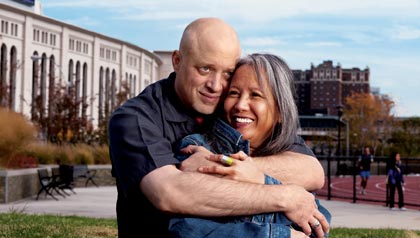When damage to the heart is irreversible, as in most cases of congestive heart failure, the pump can buy time until a donor organ is available for a heart transplant. Before he suffered a heart attack at age 47, Michael-Joshua Morris, of New York City, was exceptionally active. After his heart attack, he couldn't walk more than 10 steps without gasping for breath and leaning on his wife, Anne Marie. Two years ago he had the device implanted. "What the heart attack took away from me, the LVAD gave back to me," says Morris, who still hopes to undergo a heart transplant.
Beverly Thurman was 'so sick, I was willing to do anything to feel well again.' She now feels 'marvelous.'
Photo by Maddie McGarvey
But many older heart failure patients aren't eligible for transplants because of complicating medical conditions. A heart pump may be the only option. "Everything was going down quickly," Beverly Thurman, 64, recalls. After years of progressive heart disease, her kidneys and other organs, starved for blood, were beginning to fail. Because she had antibodies in her bloodstream that would attack foreign tissue, a heart transplant wasn't an option. When doctors at Ohio State University medical center suggested the heart pump, Thurman didn't hesitate. "I was so sick, I was willing to do anything to feel well again."
Almost two years later, Thurman says she feels "marvelous." Barely able to walk before the pump was implanted, she's now taking brisk strolls through her Columbus neighborhood at one end of a leash, pulled along by her new puppy. She and her fiancé are planning a trip to Los Angeles. "Everything is just perfect."
Next: The device can be life-changing. >>
Not all heart failure patients qualify for the device. Candidates must be healthy enough to withstand surgery and capable of managing the complex routines of charging the batteries and keeping the site where the wire connects through the abdomen sterile. But for those who qualify, the device can be life-changing. The tiny pump has proved so effective and reliable that many older patients who were once too sick to undergo surgery can go on to have hip replacements or other operations that further improve their quality of life.
To implant the pump, surgeons perform open-heart surgery. Recovery takes two weeks or more in the hospital. The wire that protrudes from the abdomen, connecting the pump to the controller and power source, must be carefully cleaned daily to prevent infection. Heart pump recipients can't swim and must be careful when taking a shower. The newest battery packs provide power for up to 14 hours — a big improvement over earlier models — allowing patients far more independence. Still, there's the reality of having to plan ahead, to make sure batteries are charged and a power source is available. And for older patients especially, the 1 1/2-pound batteries can be heavy to carry around.
But most recipients shrug off the inconveniences. "Sure, you've got a wire coming out of your gut, and batteries to worry about, and all that," says Morris. "I'm a Yankees fan, and someone once asked me if I felt as if my life was at the bottom of the ninth inning, two outs, bases loaded. The way I put it, my life is in extra innings. If I'd had my heart attack eight years ago, I wouldn't be alive. What can I be but grateful?"





































































More on Health
Get Your Doctor's Attention
How to talk so they'll listen
Best Foods for Sleep
Bananas and kiwis are good to eat for a good night's rest